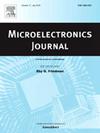Narrowband ladder-type MEMS filter based on high-Q thin-film piezoelectric-on-silicon MEMS resonators
IF 1.9
3区 工程技术
Q3 ENGINEERING, ELECTRICAL & ELECTRONIC
引用次数: 0
Abstract
This article reports a narrowband ladder-type microelectromechanical system (MEMS) filter based on thin-film piezoelectric-on-silicon (TPoS) MEMS resonators with high quality factors (). The reported second-order ladder-type MEMS filter consists of three single-port TPoS MEMS resonators. Dependencies of the resonator’s and effective electromechanical coupling factor (), as well as the filter’s bandwidth on the device thickness of the TPoS MEMS resonators are investigated using finite element method (FEM) analysis. The mechanical of the resonator increases while its decreases as the thickness of the silicon device layer become thicker from to , resulting in a lower insertion loss and narrower bandwidth for the designed filter. Measurement results illustrate that the fabricated TPoS resonator with silicon device layer of achieves a high of 50258 and of 0.094% at its resonant frequency of 25.9 MHz, which agree well with the FEM simulated values. Thanks to the high and low of the TPoS MEMS resonator, the reported ladder-type MEMS filter achieves a narrow percent bandwidth of 0.059%, a low insertion loss of 0.71 dB, and a 20-dB shape factor of 1.33 under proper termination impedance. It provides a promising way for achieving narrowband MEMS filters for channel selection at radio frequency in wireless communications.
基于高q薄膜压电硅基MEMS谐振器的窄带阶梯型MEMS滤波器
本文报道了一种基于高质量因数(Qs)的薄膜压电-硅(TPoS) MEMS谐振器的窄带阶梯式微机电系统(MEMS)滤波器。所报道的二阶阶梯型MEMS滤波器由三个单端口TPoS MEMS谐振器组成。采用有限元法分析了谐振器Q值、有效机电耦合系数(keff2)以及滤波器带宽与TPoS MEMS谐振器器件厚度的关系。随着硅器件层厚度从20μm增加到60μm,谐振器的机械Q增大,keff2减小,从而降低了滤波器的插入损耗和带宽。测量结果表明,所制备的60μm硅器件层TPoS谐振器在25.9 MHz的谐振频率下,Q值高达50258,keff2为0.094%,与有限元模拟值吻合较好。由于TPoS MEMS谐振器的高Q和低keff2,所报道的梯形MEMS滤波器在适当的终端阻抗下实现了0.059%的窄百分比带宽,0.71 dB的低插入损耗和1.33的20 dB形状因子。它为实现窄带MEMS滤波器在无线通信中用于射频信道选择提供了一种很有前途的方法。
本文章由计算机程序翻译,如有差异,请以英文原文为准。
求助全文
约1分钟内获得全文
求助全文
来源期刊

Microelectronics Journal
工程技术-工程:电子与电气
CiteScore
4.00
自引率
27.30%
发文量
222
审稿时长
43 days
期刊介绍:
Published since 1969, the Microelectronics Journal is an international forum for the dissemination of research and applications of microelectronic systems, circuits, and emerging technologies. Papers published in the Microelectronics Journal have undergone peer review to ensure originality, relevance, and timeliness. The journal thus provides a worldwide, regular, and comprehensive update on microelectronic circuits and systems.
The Microelectronics Journal invites papers describing significant research and applications in all of the areas listed below. Comprehensive review/survey papers covering recent developments will also be considered. The Microelectronics Journal covers circuits and systems. This topic includes but is not limited to: Analog, digital, mixed, and RF circuits and related design methodologies; Logic, architectural, and system level synthesis; Testing, design for testability, built-in self-test; Area, power, and thermal analysis and design; Mixed-domain simulation and design; Embedded systems; Non-von Neumann computing and related technologies and circuits; Design and test of high complexity systems integration; SoC, NoC, SIP, and NIP design and test; 3-D integration design and analysis; Emerging device technologies and circuits, such as FinFETs, SETs, spintronics, SFQ, MTJ, etc.
Application aspects such as signal and image processing including circuits for cryptography, sensors, and actuators including sensor networks, reliability and quality issues, and economic models are also welcome.
 求助内容:
求助内容: 应助结果提醒方式:
应助结果提醒方式:


